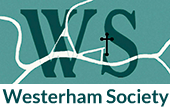The south side of Vicarage Hill has seen very little change since the dawn of photography in the 1840s. The main area of change has been on the north side of the hill, between Church Alley next to Collthurst Almshouses and ‘Darenth’, now a private residence, but once a busy greengrocers run by Harry Langridge who grew his fruit and vegetables on the Darenth Nursery site adjacent to Quebec House. A jumble of tiny back-to-back cottages stood where the flats are now sited beside the footpath to the churchyard, and these were fronted on the main road by some cottages that included Benjamin Haylett’s bootmakers shop seen here in our first photograph taken around 1909.
A walk down Vicarage Hill
Bill Curtis
Benjamin Haylett stands in the sun outside his bootmaker's shop with his wife Isabell. It would have been very gloomy working the leather in the cottage with so few windows. Darenth Nursery shop can be seen further down the hill with its distinct white frontage and cat-slide roof. Tucked in behind the furthest of these cottages was a blacksmith's forge which was working until the 1920s.
This damaged glass plate photograph dates from circa 1890 and shows three cottages that used to be attached to what was 'The Old House Inn' where the crowd are standing outside by the drayman's cart. In the foreground is the Darenth Nursery shop behind the high stone wall where the children are standing
Just beyond the 'Old House Inn' in the previous shot stood Quebec House shown here, originally known as 'Spiers' and the childhood home of James Wolfe. This photograph dates from around 1900 when the house was divided into Quebec House West and East.
Dunsdale West Lodge in 1906 with the cast iron gates it still has today. These replaced earlier solid-oak gates which gave more privacy but lent a rather sombre air to the entrance. The lamppost and direction pointers stood in the middle of the square and traffic just drove around it. On the right can be seen 'Stakes' the home of William Finnis Watkins, owner of the Swan Brewery adjacent.
The view from West Lodge up Vicarage Hill shows retail trade at this end of town. The first shop in the foreground-left is a little grocer's shop, then the white painted frontage was a pork butcher's shop run by William Dove. Opposite and further up can be seen 'The Old House Inn' with adjoining cottages which are no longer there.
Further up the hill we come to Red Cow House of today, once another Inn, but at this time, circa 1918, another grocer's shop, advertising R. White's Ginger Beer. The cottage beyond, which sat adjacent to the Vicarage at that time was called 'Copthall' as it is today, and housed a 'Small Confectioner's' shop.
This 1900 photograph shows a second advertisement for R. Whites Ginger Beer, but this time it is just below the window on the wall of Elizabeth Beal's 'Small Confectioner's' shop at Copthall.
The old Vicarage remains pretty much the same as it appears in this aquatint photo-postcard of circa 1910. The last incumbent of 'The Living' at this Vicarage was Canon Herbert Buchanan Boyd M.A. from 1920 to 1927. It has always been claimed that James Wolfe was born here on 2nd January 1727 while his parents were visiting Rev.d George Lewis and his family. The gate directly opposite led from a footpath up to the churchyard as can be seen on the 1869 map below. It is now access to the new Vicarage garden.







No Comments
Add a comment about this page